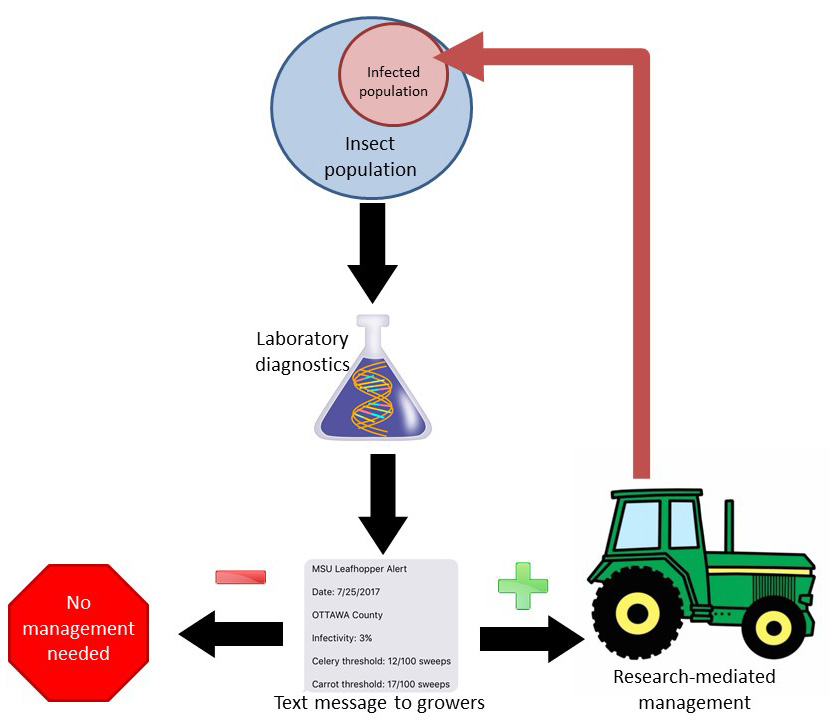Aster leafhoppers in carrots and celery: To spray or not to spray?
Helping growers accurately time sprays for aster leafhoppers in carrots and celery.

To spray or not to spray? That question was not as simple as it sounded for Michigan celery and carrot growers looking to control aster leafhopper. Unlike most agricultural pests, the aster leafhopper does little damage to crops by feeding on them. Instead, they vector (transmit) a plant disease called aster yellows phytoplasma. The challenge is that the amount of disease leafhoppers carry can vary greatly from week to week. This means that making spray decisions based on leafhopper numbers alone can be tough. On one hand, growers can ill-afford to waste time and money spraying when it is unnecessary. On the other hand, aster yellows disease can cause major losses, making it crucial to control leafhoppers when disease risk is high.
Why is aster yellows a concern? Aster yellows can impact many crops, but the most sensitive crops in Michigan are celery, carrots and lettuce. Up to 10% of the crop can die when infected leafhoppers are abundant. Those that survive may be unmarketable, as disease symptoms include leaf yellowing or bronzing, hairy roots and excessive branching (Photo 1). To manage aster yellows, growers control aster leafhoppers with insecticides.
Our goal has been to give growers the information they need to accurately assess risk of aster yellows. To accomplish this, we began sampling aster leafhoppers in Michigan celery and carrot farms starting in 2014. Scouts collect leafhoppers using sweep nets. The Michigan State University Vegetable Entomology lab then tests leafhoppers for the presence of aster yellows DNA. This provides an estimate of the percentage of the leafhoppers that are carrying the aster yellows disease each week of the growing season. We then text growers information on the percentage of leafhoppers carrying aster yellows. Our texts also have a threshold growers can use in combination with their scouting reports to make spray decisions (Photo 2). This information helps growers spray when risk is high but minimize unnecessary sprays that will not impact their bottom line.

Our results have shown the value of knowing how many leafhoppers are infected from week to week. In celery fields, we sometimes find a two-week lag between increases in leafhopper numbers and an increase in the number of leafhoppers carrying aster yellows. For example, we found that in celery there are increases in aster leafhopper numbers in mid-June, but these are not usually infected at high rates. In times like this, growers can save money by avoiding sprays. However, in late June or early July, infectivity can increase, making management at this time important.
We have also found that the high risk period for aster yellows can vary between crops. For example, in some years infected leafhoppers are not found in carrot fields until two weeks after detection in celery. This delay may be due to the geographical distribution of farms in Michigan or differences in crop production practices. Celery is transplanted and is grown to the south of the main carrot producing region. Transplanted celery likely provides an early season food source for the leafhoppers when they arrive in Michigan. Carrots are direct-sown, so they might provide a later-season food source for the leafhoppers as they continue to travel north.
We continue to perform a number of follow-up studies to help growers better control aster yellows. We are particularly interested in the relationship between aster yellows, field edges and natural areas, and if these areas can be managed to reduce infections in crops. Field edges and natural areas are known to host aster leafhoppers, but it is unclear if these areas also serve as a reservoir for aster yellows phytoplasma.
If you are interested in receiving aster yellows infectivity text messages or hosting our research, contact Ben Werling at werling@msu.edu or Zsofia Szendrei at szendrei@msu.edu.



 Print
Print Email
Email